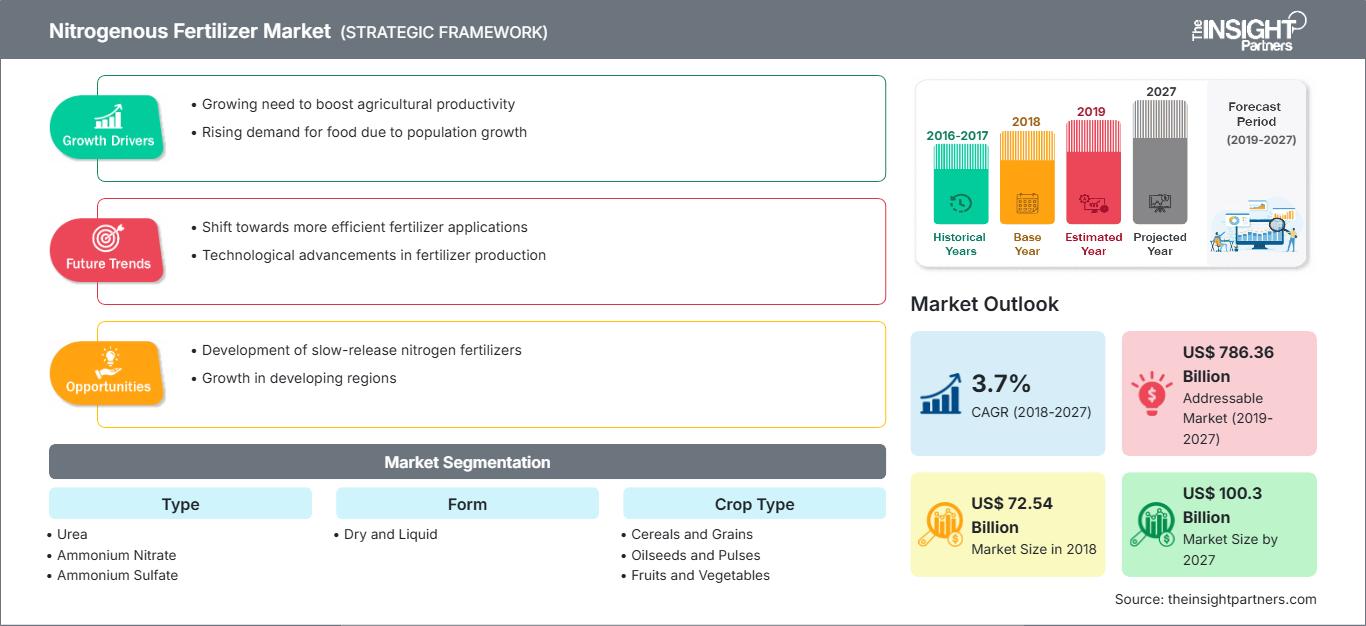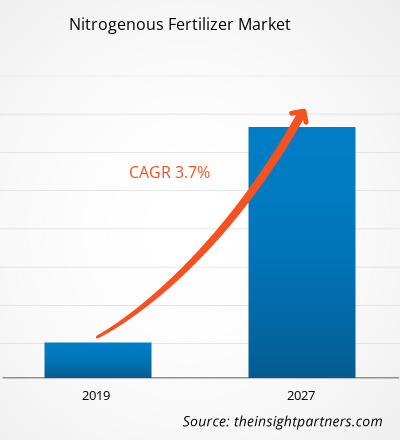The nitrogenous fertilizer market was valued at US$ 72,537.57 million in 2018 and is expected to grow at a CAGR of 3.7% from 2019 to 2027 to reach US$ 100,304.42 million by 2027.
Nitrogen fertilizer is produced by utilizing nitrogen from the air and is, then, exposed to complex chemical reaction. Nitrogen is used to promote the growth of crops and offers better texture and color to plants and, thus, helps to improve agricultural productivity. The Haber Bosch process is considered to be the most preferred technique used for the production of nitrogenous fertilizers Market. Natural gas is one of the significant raw materials, which is used in the Haber Bosch process along with other forms of raw materials such as animal manure and compost, among others. The increase in population has surged the demand for food security and, thus, drives the need to use such fertilizers to supply essential nutrients in soil to promote the soil quality, ultimately, leading to higher yields.
The nitrogenous fertilizer market in North America is expected to grow at the highest CAGR during the forecast period. North America is the fastest growing market for the nitrogenous fertilizer on account of rising applications of nitrogenous fertilizer backed by positive government measures to support the growth of the industry. Further, increase in the disposable income coupled with increased investment in better agricultural facilities is also likely to drive the demand for nitrogenous fertilizer in North America market. However, environmental and health hazards posed by the use of such synthetic fertilizers has led to increased utilization of organic agricultural products. This may impede the growth of the nitrogenous fertilizer market.
Customize This Report To Suit Your Requirement
You will get customization on any report - free of charge - including parts of this report, or country-level analysis, Excel Data pack, as well as avail great offers and discounts for start-ups & universities
Nitrogenous Fertilizer Market: Strategic Insights

-
Get Top Key Market Trends of this report.This FREE sample will include data analysis, ranging from market trends to estimates and forecasts.
Market Insights
Growth of Commercial Agriculture
Commercial agriculture is basically defined as cultivating crops to sell the produce for profit in the domestic or export market. Commercial farming has reformed and initiated a gradual evolution in the agriculture sector. Rise in population coupled with use of improved technology and better infrastructural facilities have positively impacted the growth of commercial farming. The developments in agricultural industry have laid the foundation for adopting technology and use of high quality of fertilizers to boost the yield such as nitrogen based fertilizers. Thus, the growth of commercial agriculture would further entail the increasing demand for nitrogenous fertilizers. For instance, the introduction and use of coated urea coupled with increased demand for fertilizers with blended N, P and K and adoption of coated fertilizer with yeast has gained prominence in agricultural industry to improve soil fertility. At present, the majority of agricultural operations deploy the use of advanced machinery and sophisticated technologies. For instance, the use of soil sensors and drones has become an essential part of large-scale farming, and vertical farming is expected to make multiple strides by harvesting crops without the use of sunlight or soil.
Product Insights
Based on application, is segmented into urea, ammonium nitrate, ammonium sulfate, ammonia, calcium ammonium nitrate, and others. The urea segment accounted for the largest share of the global market in 2018, whereas the market for ammonium sulfate is expected to grow at the highest CAGR during the forecast period. One of the first solid nitrogen sources manufactured on a large scale capacity is ammonium nitrate. Ammonium nitrate fertilizer is very volatile nature, which makes it beneficial in specific industries. Ammonium nitrate is nearly colorless crystal salt and odorless. Application of ammonium nitrate in gardens and large scale agricultural fields improves plant growth and provides a supply of nitrogen from which plants can draw. Ammonium nitrate fertilizer is a simple compound to produce. It is produced when ammonia gas reacts with nitric acid. The chemical reaction forms a concentrated formula of ammonium nitrate, which produces prodigious amounts of heat. As a fertilizer, the compound is smeared as granules, and fused with ammonium sulfate to lessen the volatile nature of the compound.
Application Insights
Based on crop type, is segmented into cereals and grains, oilseeds and pulses, fruits and vegetables, and others. The cereals and grains segment accounted for the largest share of the market in 2018, whereas the oilseeds and pulses segment is expected to register the highest CAGR during the forecast period. All oilseed and pulses crops require nitrogen in moderately large amounts. Nitrogen is the most limiting nutrient in oilseed and pulses production all over the globe. Crops normally take up most of their nitrogen from the soil in the form of nitrate nitrogen. When soil nitrogen levels are adequate, nitrogen promotes dynamic growth and a larger leaf area with a dark green color. Soil analysis is very useful in estimating the nitrogen fertilizer requirement. The rising demand for oils and pulses all over the globe has been one of the major contributing factors for the expansion of the nitrogenous fertilizers. The increasing inclination of people towards a healthy lifestyle has promoted to the increasing consumption of oilseeds and pulses, owing to its health benefits. Thus all these factors have fueled the demand for the nitrogenous fertilizers market and also contributed to the expansion of the market all over the globe.
A few players operating in the nitrogenous fertilizer market are Bunge Limited, CF Industries Holdings, Inc., EuroChem Group, Koch Fertilizer, Llc, Nutrien Ltd.,and OCI Nitrogen. The key companies implement the mergers and acquisitions, and research and development strategies to expand customer base and gain significant share in the global market, which also allows them to maintain their brand name globally.
Report Spotlights
- Progressive industry trends in the nitrogenous fertilizermarket to help players develop effective long-term strategies
- Business growth strategies adopted by developed and developing markets
- Quantitative analysis of the nitrogenous fertilizer market from 2019 to 2027
- Estimation of global demand for nitrogenous fertilizer
- PEST analysis to illustrate the efficacy of buyers and suppliers operating in the industry
- Recent developments to understand the competitive market scenario
- Market trends and outlook as well as factors driving and restraining the growth of the nitrogenous fertilizer market
- Assistance in decision-making process by highlighting market strategies that underpin commercial interest, leading to the market growth
- The size of the nitrogenous fertilizer market size at various nodes
- Detailed overview and segmentation of the market, as well as the Nitrogenous fertilizer industry dynamics
- Size of the nitrogenous fertilizer market in various regions with promising growth opportunities
The regional trends and factors influencing the Nitrogenous Fertilizer Market throughout the forecast period have been thoroughly explained by the analysts at The Insight Partners. This section also discusses Nitrogenous Fertilizer Market segments and geography across North America, Europe, Asia Pacific, Middle East and Africa, and South and Central America.
Nitrogenous Fertilizer Market Report Scope
| Report Attribute | Details |
|---|---|
| Market size in 2018 | US$ 72.54 Billion |
| Market Size by 2027 | US$ 100.3 Billion |
| Global CAGR (2018 - 2027) | 3.7% |
| Historical Data | 2016-2017 |
| Forecast period | 2019-2027 |
| Segments Covered |
By Type
|
| Regions and Countries Covered |
North America
|
| Market leaders and key company profiles |
|
Nitrogenous Fertilizer Market Players Density: Understanding Its Impact on Business Dynamics
The Nitrogenous Fertilizer Market is growing rapidly, driven by increasing end-user demand due to factors such as evolving consumer preferences, technological advancements, and greater awareness of the product's benefits. As demand rises, businesses are expanding their offerings, innovating to meet consumer needs, and capitalizing on emerging trends, which further fuels market growth.

- Get the Nitrogenous Fertilizer Market top key players overview
Nitrogenous Fertilizer Market- by Type
- Urea
- Ammonium Nitrate
- Ammonium Sulfate
- Ammonia
- Calcium Ammonium Nitrate
- Others
Nitrogenous Fertilizer Market – by Form
- Dry
- Liquid
Nitrogenous Fertilizer Market – by Crop Type
- Cereals and Grains
- Oilseeds and Pulses
- Fruits and Vegetables
- Others
Company Profiles
- Bunge Limited
- CF Industries Holdings, Inc.
- EuroChem Group
- Koch Fertilizer, Llc
- Nutrien Ltd.
- OCI Nitrogen
- SABIC Group
- Sinofert
- TOGLIATTIAZOT (TOAZ)
- Yara International ASA
Frequently Asked Questions
Based on type, which segment is fastest growing in the global nitrogenous fertilizer market during the forecast period?
Can you list some of the major players operating in the global nitrogenous fertilizer market?
Which region held the largest share of the global nitrogenous fertilizer market?
- Historical Analysis (2 Years), Base Year, Forecast (7 Years) with CAGR
- PEST and SWOT Analysis
- Market Size Value / Volume - Global, Regional, Country
- Industry and Competitive Landscape
- Excel Dataset
Recent Reports
Related Reports
Testimonials
Reason to Buy
- Informed Decision-Making
- Understanding Market Dynamics
- Competitive Analysis
- Identifying Emerging Markets
- Customer Insights
- Market Forecasts
- Risk Mitigation
- Boosting Operational Efficiency
- Strategic Planning
- Investment Justification
- Tracking Industry Innovations
- Aligning with Regulatory Trends





















 Get Free Sample For
Get Free Sample For